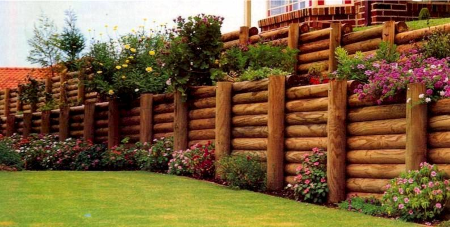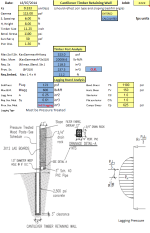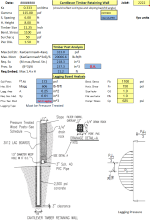Timber Post Retaining Wall

Description
When cuts less than about 8 feet are desired, cantilevered timber retaining wall become an economical choice. This worksheet is for computing the required post size, lagging board size and embedment depth.
Calculation Reference
Timber Post Retaining Wall
Retaining Wall
Soil Mechanics
Designing a timber post retaining wall involves several steps, including site analysis, load calculations, material selection, and construction. Here is a step-by-step guide to design a timber post retaining wall:
-
Site analysis: a. Investigate the site conditions, including soil properties, groundwater levels, and potential obstructions. b. Determine the height and length of the retaining wall based on the site requirements and constraints. c. Identify any surcharge loads, such as buildings or roadways near the wall.
-
Load calculations: a. Calculate the lateral earth pressure exerted by the soil using methods like Rankine or Coulomb theory. b. Consider any additional surcharge loads and water pressure, if applicable. c. Determine the factor of safety against sliding and overturning.
-
Material selection: a. Choose a suitable timber species that is resistant to decay and has the required strength properties. b. Select a timber preservative treatment to increase the longevity of the timber posts.
-
Timber post layout and sizing: a. Determine the spacing between the timber posts based on the wall height and load requirements. b. Calculate the required size of the timber posts and the embedment depth to resist lateral loads and prevent overturning. c. Choose an appropriate timber member for the wall face, such as planks, boards, or sleepers, and determine their thickness and fastening requirements.
-
Drainage and backfill: a. Design a drainage system to remove excess water from behind the wall, using methods like perforated drain pipes, gravel backfill, or weep holes. b. Select a suitable backfill material, such as well-graded gravel or sand, to minimize lateral earth pressure and promote drainage.
-
Construction details: a. Prepare the site by excavating the required area and leveling the ground. b. Install the timber posts at the predetermined spacing, ensuring they are vertically aligned and embedded to the correct depth. c. Attach the timber members for the wall face to the posts using appropriate fasteners, such as galvanized screws or bolts. d. Install the drainage system as designed and backfill the wall with the selected material, compacting it in layers to ensure adequate compaction.
-
Inspection and maintenance: a. Regularly inspect the timber retaining wall for signs of decay, rot, or structural damage. b. Address any drainage issues and maintain the wall as needed to ensure its long-term performance and stability.
Note that local building codes and regulations may have specific requirements for retaining wall design and construction. Always consult with a qualified engineer or professional when designing and constructing a timber post retaining wall to ensure it meets the necessary standards and safety requirements.
Calculation Preview
Full download access to any calculation is available to users with a paid or awarded subscription (XLC Pro).
Subscriptions are free to contributors to the site, alternatively they can be purchased.
Click here for information on subscriptions.



